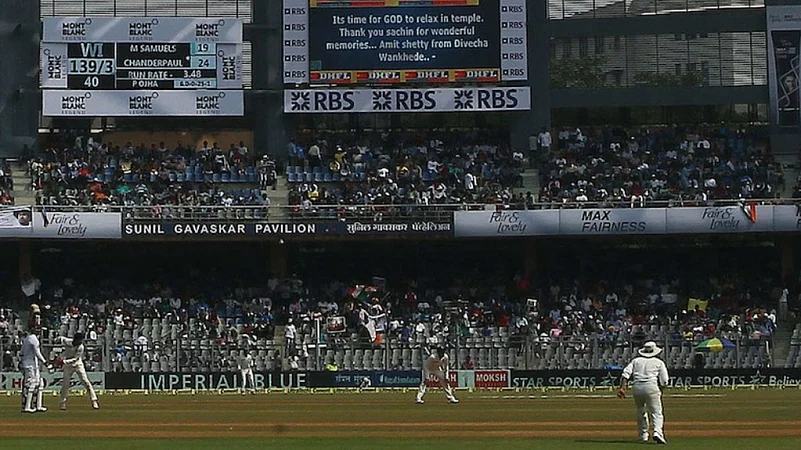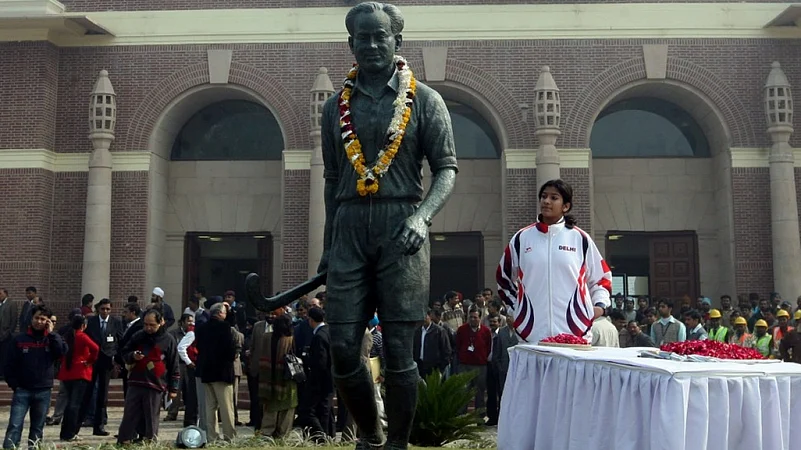When Yash Dhull and Tom Prest posed for photographs in front of the Issac Vivian Richards statue at North Sound, Antigua it was a special moment for two rising stars of world cricket. While playing the U-19 World Cup final on February 5 was indeed a special moment, leading India and England out in a stadium named after an icon of the game was no less significant. (More Sports News)
Dhull can now proudly say he won the Ur-19 World Cup in a stadium named one of the greatest cricketers of all times. Vivian Richards has been loved and saluted by the cricket fraternity all over the world and his association with India has been much more than just cricket. Richards and actress Neena Gupta, who never formally married, have a daughter, Masaba, who is a fashion designer.
Advertisement
From Richards to Shane Warne, Arthur Ashe to David Beckham, statues of famous sports personalities not only depict history and avatars who were not just physically supreme human beings but larger than life, but remembrances of good things past.

In India, statues of hockey legend Dhyan Chand at the National Stadium in New Delhi and Gostho Paul, the first captain of the Indian football team in the 1920s and 30s, in Kolkata Maidan opposite to the famous Eden Gardens, evoke similar nostalgia.
Advertisement
WHY STATUES?
What do statues really represent? Do they teach history, honour history, or be history themselves? Better yet, can they withstand the test of time? The standards should be high, and that goes for the statues that represent the heroes of American sports, wrote David Steele on the Sporting News website.
While statues or cricket stadiums named after famous industrialist and former BCCI president MA Chidambaram, popularly called the Chepauk in Chennai, or the famous Wankhede Stadium named after politician and cricket administrator Seshrao Krishnarao Wankhede have stood the test of time, renaming Delhi's historic Ferozshah Kotla to Arun Jaitley Stadium was not free from controversy.
Politics is perhaps in the air of Delhi. As the seat of power of an incredible nation, political parties have used public places of interest to gain political mileage. And since cricket is religion, venues like Kotla are a huge attraction. Naming a cricket stadium after a political honcho thus created an uproar.
After all, controversies die down but once a stadium has been named or a statue erected in India, it is very unlikely that a statue of a celebrity will be pulled down like Saddam Hussein's statue at Firdos Square in Baghdad in April 2003.
Interestingly, the man who toppled Saddam's statue almost 19 years ago was a weightlifter named Kadhim Sharif al-Jabouri. He had won several medals but Al-Jabouri became famous the day Baghdad fell to coalition forces, headed by the United States. He was shown on news television as the man in a sleeveless shirt and rippling biceps with a sledgehammer swinging away at the concrete base of Saddam's statue.
Advertisement
BEDI’S ANGST
India have a history of removing statues or desecrating faces or busts of colonial rulers like Queen Victoria, Lord Cornwallis or Lord Wellesley. Renaming Kotla, the second oldest functional cricket stadium in India, after Jaitley caused a lot of angst, especially from former Indian captain Bishan Singh Bedi.

Jaitley, a legal luminary, a former Union minister and a sports buff, had been president of the Delhi and Districts Cricket Association (DDCA) between 1999 and 2013. He had considerable clout in Indian cricket administration, controlling a large chunk of the votes that elected the BCCI office-bearers.
Advertisement
By dint of his political stature Jaitley held on to his position at DDCA but his tenure saw allegations of fraud and massive administrative bungling. He never quite had control over DDCA’s operations.
DDCA has always been a den of power-hungry officials and corruption has tarnished the association. Bedi refused to be part of DDCA and Kotla after the venue was named after Jaitley.
In a letter to the late Union minister, Bedi wrote: "Since DDCA doesn't understand this universal cricket culture, I need to walk out of it. I can't be part of a stadium which has got its priorities so grossly wrong and where administrators get precedence over the cricketers.
Advertisement
"Please bring down my name from the stand with immediate effect. You needn't worry about me or my legacy. God Almighty has been very kind to me to keep me alive with my cricketing convictions. I don't wish my strength of character to be maligned by my silence or association to this unsporting act."
LOPSIDED
It is rather ironic that a country, that swears by its star cricketers, do not have many stadiums or statues dedicated to them. Mumbai’s Wankhede stadium has stands named after Vijay Merchant, Sachin Tendulkar and Sunil Gavaskar; Pune has a statue of Professor DB Deodhar, Visakhapatnam has one of CK Nayudu, but by and large, top cricketers have been ignored and politicians like Jaitley, Madhavrao Scindia, Nehru, Patel, Narendra Modi et al have been given more prominence.
Advertisement

Non-cricketers have never figured among statues. PT Usha, Prakash Padukone, numerous Olympic gold-winning hockey players, world champion shooters and archers largely remain within the confines of history books, not more.
DO AS YOU LIKE
There is no system to decide nomenclature of stadiums or to whom and where a statue should be dedicated. As it seems, statues or stadiums are being named to please political personalities, who have never played or administered sport.
Football has been used for political gains and publicity in Goa. Industrial houses like Dempo, Vasco and Salgaocar, hotel and media owners, heavyweight politicians like the Churchill brothers and Mickky Pacheko have run football clubs to bolster their 'sporty' image.
Advertisement
Goa has produced numerous international footballers but there is not a single statue of them in the small state. So, when a statue of Cristiano Ronaldo was unveiled in Panaji by Goa minister Michael Lobo in December last year, it immediately sparked controversy.
Lobo said the 400kg statue of the Ronaldo, a global icon, was aimed at promoting and inspiring young people to take up football but residents saw no reason why a Portuguese footballer should be honoured and not an Indian. Portugal had ruled Goa for centuries before leaving Indian shores about six decades ago.
NEW WAVE?
Politics or no politics, some winds of change are blowing. India's performance at the Tokyo Olympics last year and especially Neeraj Chopra's historic gold medal in javelin, seems to have impressed politicians and policymakers. They have found clever ways to leverage the success of Olympians because unlike cricketers, they are dependent on state and central funding.
Advertisement
During the Republic Day parade this year, Haryana chose to display cutouts of Neeraj Chopra and other Olympians from the state who won medals at Tokyo 2020, on the state tableau. It is pertinent to note that Haryana's sports minister is former hockey Olympian, Sandeep Singh.
Meanwhile, the Delhi government has decided to earmark a 1 kilometer stretch in North Delhi to Olympians and Paralympians who shone for India at Tokyo 2020.
Neeraj Chopra, PV Sindhu, wrestlers Ravi Dahiya and Bajrang Punia are expected to feature on Delhi Chief Minister Arvind Kejriwal’s ambitious streetscaping project.
To be called the Olympics Vithi or Olympics Boulevard, the road will have statues and sculptures of the Olympians on a 900m stretch that will also have a synthetic track and public gym. The project will cost the AAP government close to Rs 20 Crores.




















